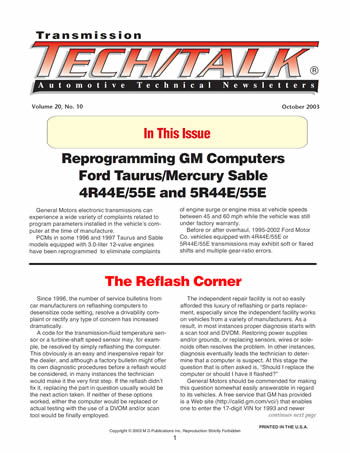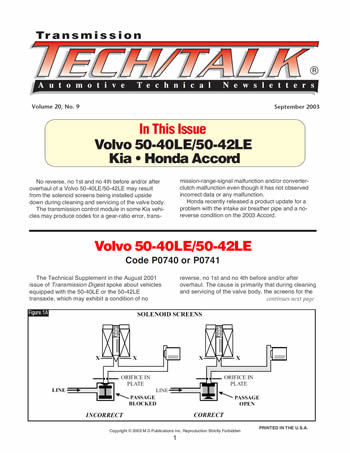October 2003 Issue
Issue Summary:
General Motors electronic transmissions can experience a wide variety of complaints related to program parameters installed in the vehicle’s computer at the time of manufacture.
PCMs in some 1996 and 1997 Taurus and Sable models equipped with 3.0-liter 12-valve engines have been reprogrammed to eliminate complaints of engine surge or engine miss at vehicle speeds between 45 and 60 mph while the vehicle was still under factory warranty.
Before or after overhaul, 1995-2002 Ford Motor Co. vehicles equipped with 4R44E/55E or 5R44E/55E transmissions may exhibit soft or flared shifts and multiple gear-ratio errors.

It Ain’t Just Oil
One thing we have seen that is consistent in the repair industry has been an unprecedented explosion of new and changing technology. An amazing number of new transmission and transfer-case designs soon will be appearing in your shop. The ever-increasing use of computer and electronic controls has made all the units more sophisticated, and diagnosis is becoming a stand-alone specialty.

Problems With Metric Cooler-Line Fittings
Few things slow down an R&R job like frozen cooler-line fittings. The metric cooler-line fittings used in Isuzu 4L30 applications and Toyota trucks with A340/30-40LE (see Figure 1) are frustrating enough to make you want to reach for the tubing cutter and start cutting rather than struggle with stubborn lines.

I Hate Noises
By this time, I guess you’ve figured out that this article has to do with noise. I’m sure many of you reading this have your own noise-related horror stories. Noises are difficult to diagnose when you’re standing right there; on the phone, they’re next to impossible. (Have I mentioned that I hate noises?)

Plumber’s Helper
This month’s problem/fix comes to us from overseas and concerns the ZF 5-HP-24 transmission. Although this problem has occurred primarily in Jaguars in this shop, it also could occur in other makes using this transmission.
Here is how the symptoms were described to me: The car comes in with a complaint of harsh upshifts and downshifts, no codes are stored, and the transmission is not in limp mode.

September 2003 Issue
Issue Summary:
No reverse, no 1st and no 4th before and/or after overhaul of a Volvo 50-40LE/50-42LE may result from the solenoid screens being installed upside down during cleaning and servicing of the valve body.
The transmission control module in some Kia vehicles may produce codes for a gear-ratio error, transmission-range-signal malfunction and/or converter-clutch malfunction even though it has not observed incorrect data or any malfunction.
Honda recently released a product update for a problem with the intake air breather pipe and a no-reverse condition on the 2003 Accord.

KM End-Clutch Failure
Have you ever noticed that most of the complaints or failures you have with a KM involve a burned end clutch? The complaints tend to be sliding 1-2, 2-3 spin-up, neutraling on the 3-4 shift, delayed engagements, no forward or no reverse.
I’ve seen every one of these complaints, only to find the end clutch burned. You might be thinking, “What does a burned end clutch have to do with a sliding 1-2 shift?”

Synchronization: A Study in Timing
Manual-shift transmissions have been manufactured with synchronized gear train for decades. The early designs were three-speed transmissions with 2nd and 3rd gears synchronized, and as transmission design progressed, four-, five- and six-speed transmissions were developed. At this point all forward speeds were commonly synchronized, and as the purchase costs of the vehicles increased and customers became more demanding, reverse was synchronized in most late-model vehicles. Synchronizers remain the most-misunderstood components in manual transmissions and transfer cases and therefore cause a great number of diagnostic headaches and comebacks.

Hot Tech From the Hotline
Have you ever encountered spin-out of the front pump bushing on a Mitsubishi KM unit as shown in Figure 1? Several years ago Paul Yaklin produced a bulletin explaining how the converter pilot bushing would get stuck on the pilot of the converter (see Figure 2). When the converter is removed, the pilot bushing stays with the converter unnoticed. Inevitably, a rebuilt converter then is installed without the adapter bushing in the crank bore. As a result, the centerline of the converter becomes seriously misaligned.

The Road to Hell is Paved With Good Intentions
Dynamic emissions testing on chassis dynamometers can be disastrous for all-wheel-drive transfer cases
In my distant youth, my mother often said to me, “The road to Hell is paved with good intentions.” During those years it never dawned on me how true those words were, but as I aged it became clear how smart my mother really was.

Figuring Out the Fuso
We have had some confusion on the ATSG help lines in reference to 1999 and later Mitsubishi Fuso tilt-cab medium-duty trucks equipped with the Aisin Seiki.
The first problem is, how do I get codes out of these trucks? Since aftermarket scan tools do not communicate with these trucks, data is not available and code retrieval must be done via the flash-code method. That means that a certain procedure must be performed, after which a light somewhere on the dash will flash a code pattern. The illustration in Figure 1 shows the locations of the diagnosis switch and the memory-clear switch, both of which are single-pin connectors.

Coolers and Contaminants
Most of us have been battling cooler and contamination issues for years. We may not realize it, nor care to look for it, but it does manage to rear its ugly head.
First we need to look at the sources. Mike Steen (technical director at Certified Transmission) has spent considerable time on finding these sources. Along the way, I have found a few as well. Hung valves and stuck governors have plagued us for years. We thought the contaminants came from coolers. We bought flushers and flushed coolers, and the problem went away – well, not quite. We still have problems.

